| Listing 1 - 10 of 13 | << page >> |
Sort by
|
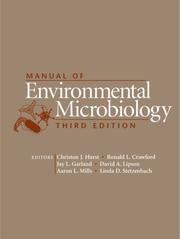
ISBN: 1555813798 9781555813796 Year: 2007 Publisher: Washington (D.C.) : ASM press,
Abstract | Keywords | Export | Availability | Bookmark
 Loading...
Loading...Choose an application
- Reference Manager
- EndNote
- RefWorks (Direct export to RefWorks)
Environmental Microbiology. --- Microbial ecology --- Sanitary microbiology

ISBN: 9781555814229 1555814220 1283034107 9786613034106 1555815812 9781283034104 661303410X 9781555815813 Year: 2007 Publisher: Washington, D.C.
Abstract | Keywords | Export | Availability | Bookmark
 Loading...
Loading...Choose an application
- Reference Manager
- EndNote
- RefWorks (Direct export to RefWorks)
"Identifies extremophiles, explores their unique ecologies, explains their physiologies, and discusses biotechnological applications. Describes the environments where these organisms reside and sheds light, at the molecular level, on the mechanisms that enable these unique organisms to survive. Covers all known types of extremophiles (including thermophiles, psychrophiles, halophiles, acidophiles, piezophiles, and alkaliphiles). Serves as an essential volume for a variety of scientists, including microbiologists, biochemists, physiologists, biotechnology specialists, ecologists, and physical scientists such as chemists and astronomers." -- Publisher's description.
Extreme environments --- Milieux extrêmes --- Microbiology. --- Microbiologie --- ADAPTATION, PHYSIOLOGICAL --- ARCHAEA --- BACTERIAL PROTEINS --- BIODIVERSITY --- ENVIRONMENTAL MICROBIOLOGY --- EXTREME ENVIRONMENTS --- MICROBIOLOGY --- PHYSIOLOGY
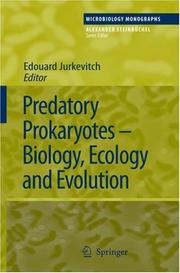
ISBN: 9783540385776 3540385770 364207247X 9786610727414 1280727411 3540385827 Year: 2007 Publisher: Berlin ; New York : Springer,
Abstract | Keywords | Export | Availability | Bookmark
 Loading...
Loading...Choose an application
- Reference Manager
- EndNote
- RefWorks (Direct export to RefWorks)
Predatory Prokaryotes focuses on the ecology of predation at the microbial level. It aims to increase the awareness of the great possibilities that predation between microbes offer for studying and discussing basic ecological and general biological concepts. This volume contains chapters on the diversity, ecology and phylogeny of predatory prokaryotes, introducing models of predator–prey interactions between microorganisms and presenting analyses of the impact of predation in microbial systems. Laboratory work with Bdellovibrio-and-like organisms (BALOs), the most studied predatory bacteria, is presented through accounts of the cultivation and the molecular techniques used for studying BALOs. A first comparative analysis of different BALO genomes is also provided. Further chapters discuss the chemotactic, regulatory and sensory circuits of these ubiquitous predatory bacteria. Finally, the unique biochemicals used as building blocks and new proteins found in BALO cell walls are reviewed.
Prokaryotes. --- Prokaryotes --- Procaryotes --- Physiology. --- Bdellovibrio -- physiology. --- Prokaryotes -- Physiology. --- Prokaryotic Cells -- physiology. --- Prokaryote physiology --- Monera --- Procaryotae --- Prokaryonta --- Prokaryotae --- Prokaryotic protists --- Life sciences. --- Microbial ecology. --- Microbiology. --- Life Sciences. --- Microbial Ecology. --- Microorganisms --- Environmental microbiology --- Ecology --- Microbiology --- Microbial biology --- Biology
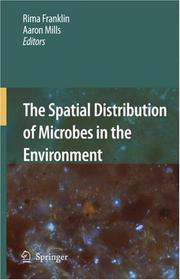
ISBN: 1281066621 9786611066628 1402062168 140206215X 9048175704 Year: 2007 Publisher: Dordrecht : Springer,
Abstract | Keywords | Export | Availability | Bookmark
 Loading...
Loading...Choose an application
- Reference Manager
- EndNote
- RefWorks (Direct export to RefWorks)
Microbes are very small and, as individuals, are capable of influencing a portion of the environment only slightly larger than their own body size, i.e., a few microns. However, their impact on the landscape is enormous, and ecosystem processes such as organic matter decomposition, denitrification, and metal oxidation/reduction are measured on scales of meters to kilometers. This volume highlights recent advances that have contributed to our understanding of spatial patterns and scale issues in microbial ecology, and brings together research conducted at a range of spatial scales (from µm to km) and in a variety of different types of environments. These topics are addressed in a quantitative manner, and a primer on statistical methods is included to aid the unfamiliar reader. In soil ecosystems, both bacteria and fungi are discussed, and the spatial patterns are interpreted in an ecological context that considers issues such as nutrient availability, vegetation distribution and growth patterns, and microbial colonization. In aquatic systems, focus is on the distribution of planktonic forms including phytoplankton and microzooplankton. The reader should gain insight on how to integrate information across spatial scales, which is necessary in order to understand and predict how these tiny organisms can have such a profound effect on landscape and ecosystem-level processes.
Microbial ecology. --- Microorganisms. --- Environmental microbiology --- Microorganisms --- Ecology --- Microbiology --- Germs --- Micro-organisms --- Microbes --- Microscopic organisms --- Organisms --- Statistics. --- Microbial Ecology. --- Statistics for Engineering, Physics, Computer Science, Chemistry and Earth Sciences. --- Biogeosciences. --- Statistical analysis --- Statistical data --- Statistical methods --- Statistical science --- Mathematics --- Econometrics --- Statistics . --- Geobiology. --- Biology --- Earth sciences --- Biosphere
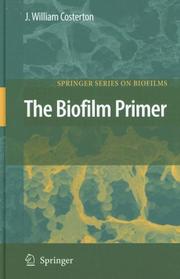
ISSN: 18639607 ISBN: 1280805358 9786610805358 3540680225 3540680217 Year: 2007 Volume: 1 Publisher: Berlin ; New York : Springer,
Abstract | Keywords | Export | Availability | Bookmark
 Loading...
Loading...Choose an application
- Reference Manager
- EndNote
- RefWorks (Direct export to RefWorks)
This book details the widely accepted hypothesis that the majority of bacteria in virtually all ecosystems grow in matrix-enclosed biofilms. The author, who proposed this biofilm hypothesis, uses direct evidence from microscopy and from molecular techniques, presenting cogent reasons for moving beyond conventional culture methods that dominated microbiology throughout the last century. Bacteria grow predominantly in biofilms in all natural, engineered, and pathogenic ecosystems, and this book provides a solid basis for the understanding of bacterial processes in environmental, industrial, agricultural, dental and medical microbiology. Using a unique "ecological" perspective, the author explores the commensal and pathogenic colonization of human organ systems.
Biofilms. --- Biofilms --- Microbiological Phenomena --- Phenomena and Processes --- Biology --- Health & Biological Sciences --- Microbiology & Immunology --- Microbial ecology. --- Life sciences. --- Medical microbiology. --- Infectious diseases. --- Microbiology. --- Bacteriology. --- Life Sciences. --- Microbial Ecology. --- Medical Microbiology. --- Infectious Diseases. --- Environmental microbiology --- Microorganisms --- Ecology --- Microbiology --- Microbial biology --- Biosciences --- Sciences, Life --- Science --- Microbial aggregation --- Microbial ecology
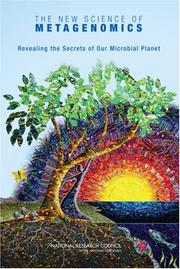
ISBN: 9780309106764 0309106761 9786610844555 1280844558 030910677X 0309185750 Year: 2007 Publisher: Washington, D.C. : National Academies Press,
Abstract | Keywords | Export | Availability | Bookmark
 Loading...
Loading...Choose an application
- Reference Manager
- EndNote
- RefWorks (Direct export to RefWorks)
Molecular biology --- Microbial genomics --- Microbial genetics --- Microbial genomics. --- Sequence Analysis, DNA --- Genomics --- Genetics, Microbial --- Environmental Microbiology --- Sequence Analysis --- Microbiology --- Public Health --- Computational Biology --- Genetics --- Biology --- Environment and Public Health --- Genetic Techniques --- Biological Science Disciplines --- Health Care --- Investigative Techniques --- Natural Science Disciplines --- Analytical, Diagnostic and Therapeutic Techniques and Equipment --- Disciplines and Occupations --- Health & Biological Sciences --- Genomics. --- Genetics. --- Bioinformatics.
Book
ISBN: 1281779288 9786611779283 3540718400 3540718397 Year: 2007 Publisher: Berlin, Heidelberg : Springer-Verlag,
Abstract | Keywords | Export | Availability | Bookmark
 Loading...
Loading...Choose an application
- Reference Manager
- EndNote
- RefWorks (Direct export to RefWorks)
After the publication of Volume IV in 1997, the introduction of molecular methods into ecology led to significant new findings. Emphasizing these advances, the chapters for the second edition have been completely updated and revised. This volume provides insight into current research on fungal populations and communities. It focuses on fungal responses to the physical environment, interactions with other fungi, microorganisms and invertebrates, the role of fungi in ecosystem processes such as decomposition and nutrient cycling, and aspects of biogeography and conservation. Several chapters deal with various applications in, e.g. biological pest control, natural products discovery, and the degradation of toxic organic compounds. This is an invaluable source of information both for scientists who wish to update their knowledge of current progress and for graduate students interested in obtaining a first overview of this field of research.
Mycology --- Mycology. --- Research. --- Botany --- Fungi --- Microbiology --- Microbial ecology. --- Molecular ecology. --- Microbiology. --- Agriculture. --- Plant physiology. --- Biotechnology. --- Microbial Ecology. --- Molecular Ecology. --- Plant Physiology. --- Chemical engineering --- Genetic engineering --- Plants --- Physiology --- Farming --- Husbandry --- Industrial arts --- Life sciences --- Food supply --- Land use, Rural --- Microbial biology --- Biology --- Microorganisms --- Ecology --- Molecular biology --- Environmental microbiology --- Molecular aspects
Book

ISBN: 9780387755311 9780387755328 0387755314 1489991328 9786611926960 1281926965 0387755322 Year: 2007 Publisher: New York, NY Springer New York
Abstract | Keywords | Export | Availability | Bookmark
 Loading...
Loading...Choose an application
- Reference Manager
- EndNote
- RefWorks (Direct export to RefWorks)
Microalgae have been largely cultured and commercialized as food and feed additives, and their potential as source of high-added value compounds is well known. But, in contrast to the large number of genetically modified bacteria, yeast and even higher plants, only a few species of microalgae have been genetically transformed with efficiency. Initial difficulties in the expression of foreign genes in microalgae have been progressively overcome, and powerful molecular tools for their genetic engineering are now on hand. A considerable collection of promoters and selectable marker genes and an increasing number of genomic or cDNA sequences have become available in recent years. More work is needed to transform new species of microalgae, specially those that have commercial value, so that it would be possible to increase the productivity of traditional compounds or synthesize novel ones. Silencing transgenes remains as an important limitation for stable expression of foreign genes. This problem is not unique to microalgae since it has also been observed in plants, animals and fungi. A better understanding of the mechanisms that control the regulation of gene expression in eukaryotes is therefore needed. In this book a group of outstanding researchers working on different areas of microalgae biotechnology offer a global vision of the genetic manipulation of microalgae and their applications.
Algae --- Biological Factors --- Bioreactors. --- Biotechnology --- Genetic transformation. --- Microalgae --- Transformation, Genetic. --- physiology. --- biosynthesis. --- methods. --- Biotechnology. --- Physiology. --- Plant science. --- Botany. --- Cell biology. --- Microbial ecology. --- Plant Sciences. --- Cell Biology. --- Microbial Ecology. --- Environmental microbiology --- Microorganisms --- Ecology --- Microbiology --- Botanical science --- Floristic botany --- Phytobiology --- Phytography --- Phytology --- Plant biology --- Plant science --- Biology --- Natural history --- Plants --- Cell biology --- Cellular biology --- Cells --- Physiology
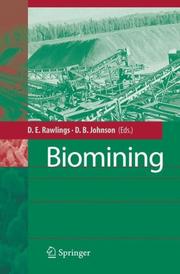
ISBN: 1280727268 9786610727261 3540349111 354034909X 3642071155 Year: 2007 Publisher: Berlin : Springer,
Abstract | Keywords | Export | Availability | Bookmark
 Loading...
Loading...Choose an application
- Reference Manager
- EndNote
- RefWorks (Direct export to RefWorks)
Biomining is the biotechnology that uses microorganisms to recover metals, in particular copper and gold, from ores and concentrates. Having developed from a very simple operational (in terms of both engineering and biology) process, biomining has developed into a multifaceted technology, to the extent that many of the largest industrial stirred tanks and heaps throughout the world are employed for bioprocessing minerals. This book has a strong applied approach and describes emerging and established industrial processes, as well as the underlying theory of the process, and the biology of the microorganisms involved. Chapters have been written by personnel from leading biomining companies, consultants and internationally recognized researchers and academics.
Minerals --- Biotechnology. --- Chemical engineering --- Genetic engineering --- Biomining --- Mineral bioprocessing --- Mineral biotechnology --- Biotechnology --- Metallurgy --- Mining engineering --- Microbiology. --- Materials. --- Microbial ecology. --- Geochemistry. --- Metallic Materials. --- Microbial Ecology. --- Biogeosciences. --- Chemical composition of the earth --- Chemical geology --- Geological chemistry --- Geology, Chemical --- Chemistry --- Earth sciences --- Environmental microbiology --- Microorganisms --- Ecology --- Microbiology --- Engineering --- Engineering materials --- Industrial materials --- Engineering design --- Manufacturing processes --- Microbial biology --- Biology --- Materials --- Metals. --- Geobiology. --- Biosphere --- Metallic elements --- Chemical elements --- Ores
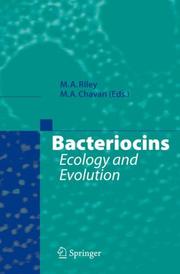
ISBN: 3540366040 3540366032 3642071708 Year: 2007 Publisher: Berlin ; New York : Springer,
Abstract | Keywords | Export | Availability | Bookmark
 Loading...
Loading...Choose an application
- Reference Manager
- EndNote
- RefWorks (Direct export to RefWorks)
Microbes produce an extraordinary array of defense systems. These include bacteriocins, a class of antimicrobial molecules with narrow killing spectra, produced by bacteria. The book describes the diversity and ecological role of bacteriocins of Gram-positive and Gram-negative bacteria, presenting a new classification scheme for the former and a state-of-the-art look at the role of bacteriocins in bacterial communication. It discusses the molecular evolution of colicins and colicin-like bacteriocins, and provides a contemporary overview of archaeocins, bacteriocin-like antimicrobials produced by archaebacteria. Furthermore, various modeling (in silico) studies elucidate the role of bacteriocins in microbial community dynamics and fitness, delving into rock-paper-scissors competition and the counter-intuitive survival of the weakest. The book makes compelling reading for a multi-faceted scientific audience, including those working in the fields of biodiversity and biotechnology, notably in the human and animal health domain.
Bacteriocins. --- Gram-negative bacteria. --- Gram-positive bacteria. --- Bacteria --- Antibacterial agents --- Bacteriology. --- Microbial ecology. --- Microbiology. --- Biochemistry. --- Evolution (Biology). --- Microbial Ecology. --- Biochemistry, general. --- Evolutionary Biology. --- Medical Microbiology. --- Animal evolution --- Animals --- Biological evolution --- Darwinism --- Evolutionary biology --- Evolutionary science --- Origin of species --- Biology --- Evolution --- Biological fitness --- Homoplasy --- Natural selection --- Phylogeny --- Biological chemistry --- Chemical composition of organisms --- Organisms --- Physiological chemistry --- Chemistry --- Medical sciences --- Microbial biology --- Microorganisms --- Environmental microbiology --- Ecology --- Microbiology --- Composition --- Evolutionary biology. --- Medical microbiology.
| Listing 1 - 10 of 13 | << page >> |
Sort by
|

 Search
Search Feedback
Feedback About UniCat
About UniCat  Help
Help News
News